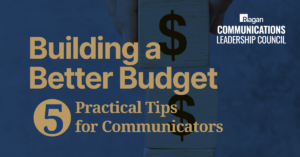Advocating for comms budget in ‘the land of unfunded mandates’
With budget season upon us, communications leaders must get creative in making their case.

With budget season upon us, communications leaders must get creative in making the case for securing the resources they need.
Because comms is often the coordinator and convener of cross-departmental campaigns and initiatives, it often means securing the resources required to do quality work is contingent on others who don’t sit at the same crossroads.
“In my experience, comms can be the land of ‘unfunded mandates’,” said Shannon Iwaniuk, a senior communications leader at a global life sciences company. “We are often pulled into supporting events, activities and leaders/corporate initiatives that haven’t been expressly on the plan or effectively accounted for in the budget. This is especially true for teams that are forming or growing.”
“Communications is often relegated to scrounging leftover cookie crumbs from the office budget party,” agrees communications leader and Ragan Advisory Board member Amanda Ponzar, adding that most comms leaders are understaffed, stuck with small budgets or see their budgets first to be cut because leadership doesn’t understand the value.
Iwaniuk sees this as a charge for communicators to think critically on what is needed to communicate effectively and consistently.
“As comms pros, we’re masters of pulling the rabbit out of the hat and making the impossible happen through sheer grit and will,” she continued. “That’s fine for a first time or an emergent situation, but the discipline comes when we do an effective and honest after-action report, when we plan for how to replicate and optimize for the future.”
Connecting needs to goals through correlation modeling
Addressing this starts with understanding your organization’s goals, then demonstrating how you’re helping meet those goals in measurable, tangible ways.
This process is the same whether you’re working in internal or external communications, PR or marketing. But what those ways will depend on your business and industry.
“For nonprofits and smaller organizations, it’s almost always related to revenue or fundraising,” Ponzar said, “though many leaders love being featured in media articles. Seven or eight years ago, after our CEO was interviewed on the front page of USA Today, he asked me how much money it raised…and the answer was nothing…so I had to rethink everything.”
She began measuring ROI by looking at marketing/fundraising correlation modeling.
“I could show fundraising increased around the days we ran certain email marketing or social media campaigns, thus justifying the small investment in marketing/comms,” explained Ponzar. “Last year, the funds raised in one large campaign increased significantly enough that the increase alone covered the marketing investment three times over—and the total raised was much higher than that.”
Asking for what you need
Ponzar used to receive an allocated budget, but for the past few years she’s instead been building detailed budgets in an excel spreadsheet a year out to make the case for investment.
This exercise underscores how “much of comms is related to keeping the communication lights on,” she said, listing a series of peripheral investments like website hosting sites and widgets, graphic design software, social media scheduling platforms, monitoring tools and more.
“This isn’t usually advancing communication initiatives. It’s just the building blocks.”
With today’s algorithms and competitive landscape, Ponzar found that paid media budget was also a necessary part of most initiatives. This required her to ask for a paid social budget or a satellite media tour.
“For each project, I’d build a comms plan or menu of options showing how we could use our owned channels—the ‘free’ social media, website, newsletter/email, etc—but also including all the paid options and recommending funding for those pieces.”
Iwaniuk adds that effective measurement is not just about the number of stories or posts, but also about demonstrating behavioral change.
“Have the courage to ask for what you need to deliver in a way that adds value to your organization and its leaders, supports the business and builds engagement and culture,” said Iwaniuk.
Asking for budget through this lens empowers you to draw a correlation between employee experience and culture, engagement and retention— an effective way to connect brand reputation back to tangible outcomes like productivity and retention.
Collaborating with other functions
It’s no secret that communicators are often uncomfortable with talking about numbers and budgets. This is when it might feel easier to outsource month-to-month budget needs to an administrative partner. But partnering with them instead will educate you on how they think and strengthen the likelihood of earning their support.
Ponzar advises communicators to establish a close rapport with their finance partners by knowing their numbers in advance of establishing a close rapport, even if it means seeking out business fluency resources online.
“I started by panhandling, asking my peers and other department heads who valued the work my team was leading to help fund us,” she said. One-on-one calls were most effective.
“When they saw how small our budget was and admitted they needed our help to achieve their goals as we’re interdependent, they almost had no choice but to fund our team’s work if they wanted publicity, promotions, advertising, etc.,” Ponzar continued.
She also emphasized that building alliances to get the funding needed begins with having a conversation.
“This means making the case at the executive level for a communications line item to be included in every new proposal, contract, memorandum of understanding (MOU) and project,” she said. “Otherwise, Comms is saddled with unrealistic asks, without the resources required to promote the project or achieve organizational, let alone department, goals.”
Ponzar also draws a parallel between asking for budget and HR or Finance departments adding a percentage to an employee’s salary to cover fringe benefits. Positioning your asks not as nice-to-haves or extra, but as providing a more accurate view of the total cost, normalizes the idea that communications must be included in your organization’s goals.
“Start with your allies who value and understand the work you do,” she said. “Over time, as you measure and continue to report your results, those allies –and your funding — should grow.”
Justin Joffe is the editorial director and editor-in-chief at Ragan Communications. Follow him on LinkedIn.
Additional resources on securing comms budgets, including our forthcoming budget report, are available exclusively to members of Ragan’s Communications Leadership Council. Learn more about joining here.







